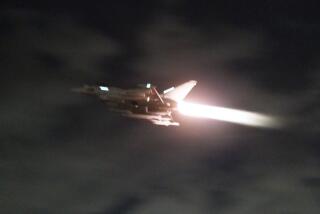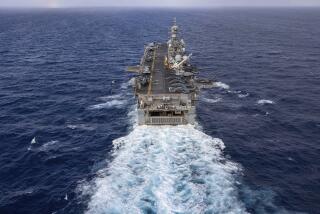U.S. Had Warning of Possible New Iranian Mines
- Share via
WASHINGTON — The night before a mine damaged the supertanker Bridgeton in the Persian Gulf, U.S. military commanders were alerted that the Iranians might be planting mines in the path of the convoy of American warships and re-registered Kuwaiti oil tankers, Administration officials say.
But the “intelligence”--believed to come from surveillance aircraft or satellites--”was not strong enough to stop the convoy,” one official said.
The Bridgeton, a 400,000-ton Kuwaiti tanker which had been re-registered under the U.S. flag, was being escorted by three U.S. Navy warships when it hit the mine on the morning of July 24 near Iranian-controlled Farsi Island, about 130 miles southeast of Kuwait.
No Similar Encounters
Neither the U.S. ships nor a second Kuwaiti tanker in the convoy, the Gas Prince, encountered similar mines. The Bridgeton, which was empty at the time, suffered damage to its hull and to four compartments but was able to proceed slowly to port in Kuwait. There, it is taking on a partial load of oil and is scheduled to be escorted back out of the gulf by the U.S. Navy. After offloading the oil to smaller tankers outside the gulf, the Bridgeton will go into a Middle Eastern port for repairs.
Meanwhile, the Gas Prince, having loaded its cargo of liquefied petroleum gas, was reported Saturday to be under way on the return leg of its gulf voyage with an escort of U.S. warships.
Disclosure that U.S. intelligence had detected Iranian activity in the region of Farsi Island on the night of July 23 came as Administration officials said President Reagan had been told by military planners six weeks ago that the Iranians were sowing mines in parts of the gulf. But the military planners attached a “low probability” to the mine threat in the open seas, the officials said.
‘Mining Was Discussed’
When Adm. William J. Crowe Jr., chairman of the Joint Chiefs of Staff, briefed Reagan at a meeting of a National Security Council planning group in mid-June, “mining was discussed, including mining of open waterways,” said one knowledgeable official. But Pentagon planners “didn’t anticipate mines in the area because none had been found there before. . . . It was not accorded a heavy probability.”
About a dozen mines believed planted by the Iranians had been removed earlier from approaches to Kuwaiti harbors by a team of American experts working with Saudi minesweepers. And in the period from mid-May to mid-June, four merchant ships, including one Soviet ship, had hit mines in the gulf.
But, one Administration official said, it was “felt that if something like this would occur, there would be warning. If mines were being laid, intelligence would show it up.
‘There Was Some Evidence’
“It did show up,” this official added. “There was some evidence of Iranian activity in the region the night before, but not strong enough to stop the convoy.”
The official did not elaborate, but by “intelligence” he apparently was referring to information-gathering by U.S. surveillance aircraft and satellites. Experts say that the movements of even small boats can be detected by such means.
The Iranian navy, plagued by maintenance problems and the lack of spare parts, has few large warships still in service. The heart of the Iranian naval threat, experts say, is a fleet of about 100 Swedish-made high-speed patrol boats. These boats, some manned by members of the Iranian Revolutionary Guard rather than by sailors of the regular Iranian navy, are believed to be based in about five locations in the gulf, including Farsi Island.
Aging, Crude Mines
Mines planted in the past by the Iranians are described by intelligence sources as of 1908 Russian design and are believed to have been manufactured in North Korea.
But even aging, crude mines can be “very dangerous, very effective, very insidious weapons,” Capt. Joseph Kennedy, head of the Navy’s mine warfare branch, told a Pentagon briefing last week.
Several Soviet minesweepers have been operating in the gulf in recent months. Last week, in the wake of the explosion that damaged the Bridgeton, the United States took steps to move eight large minesweeping helicopters toward the gulf. The copters are expected to be in position and ready for operation in about a week.
More to Read
Sign up for Essential California
The most important California stories and recommendations in your inbox every morning.
You may occasionally receive promotional content from the Los Angeles Times.













